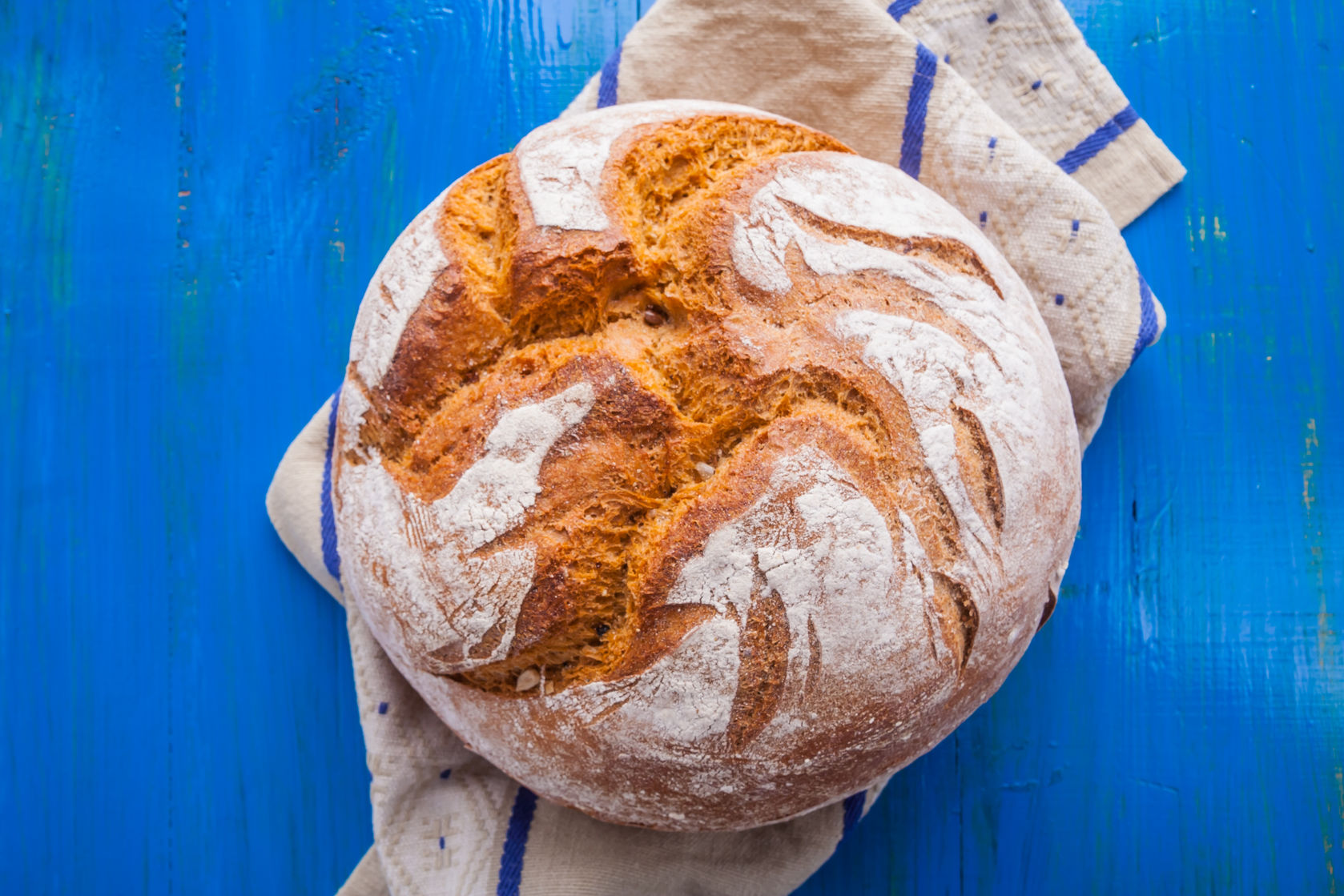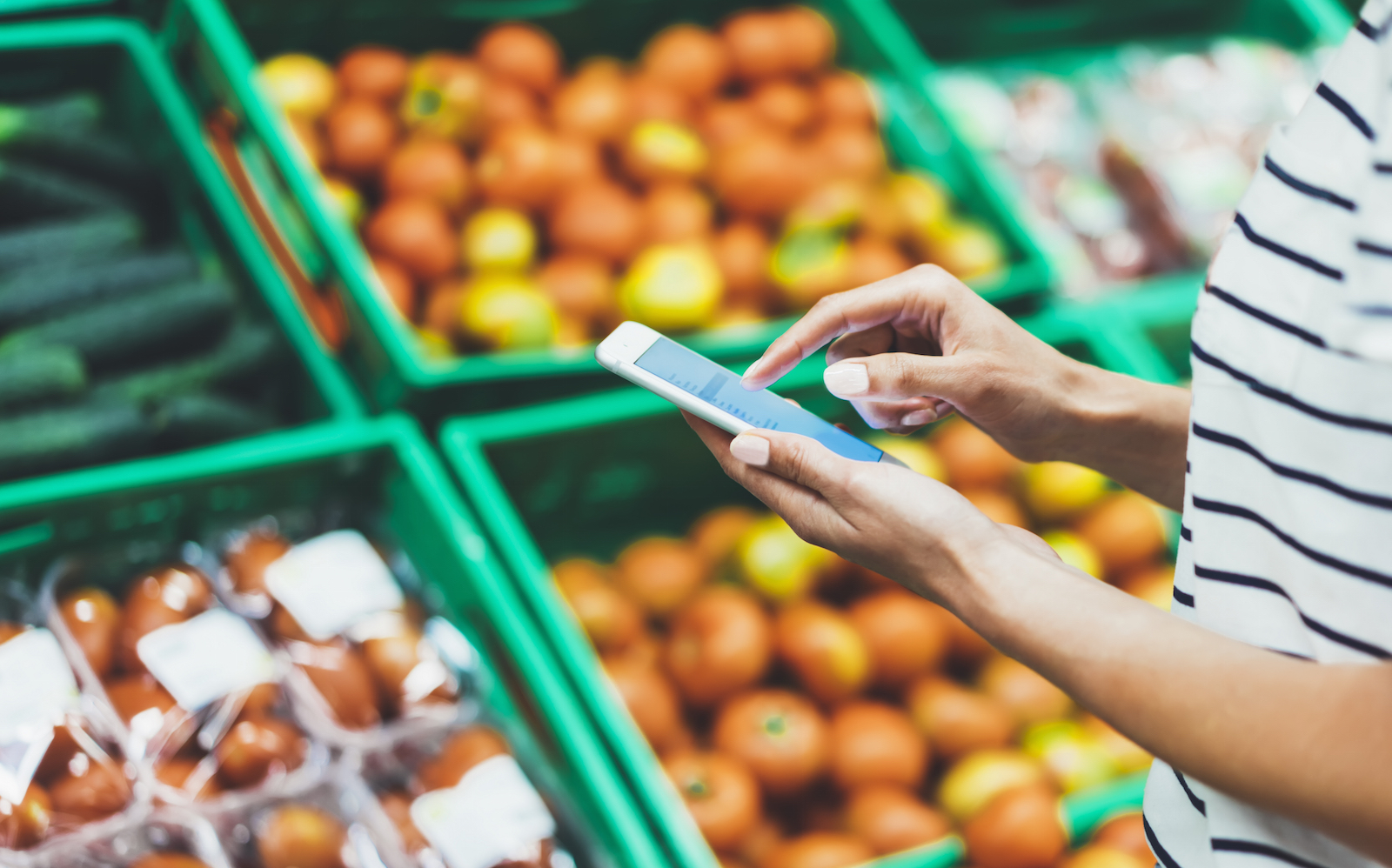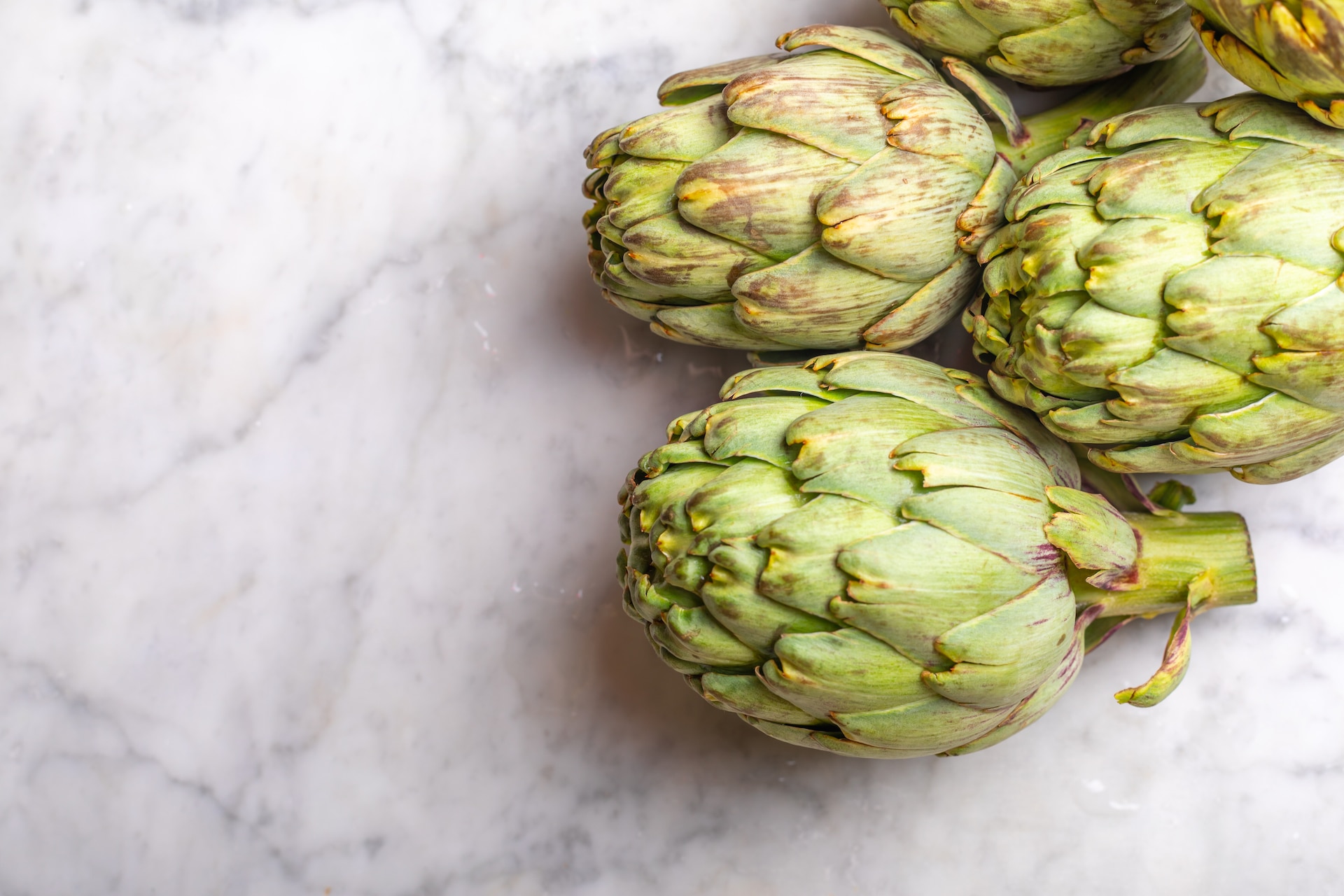Healthy Eating for Diabetes: The Best Nutritious Snacks and Tasty Breakfast Ideas
By Seka PalikucaHome » Coach » Healthy Eating for Diabetes: The Best Nutritious Snacks and Tasty Breakfast Ideas
If you’re living with diabetes, the biggest hurdle is often knowing what to eat and what not to eat—especially when it comes to snack time and breakfast.
Choosing foods that are high in fiber, protein, and healthy fats is essential. These foods will work hard to help keep blood sugar levels where they need to be.
Read up on what diabetes is, how to help control it with healthy snacks, and some delicious breakfast ideas to start the day off right.
What is Diabetes?
More than 34 million Americans have diabetes (about 1 in 10), according to the Centers for Disease Control and Prevention (CDC). Diabetes is a chronic condition that affects how the body turns food into energy. When we eat, food is broken down into glucose (sugar) and sent into our bloodstream. When our blood sugar rises, it signals our pancreas to release insulin.
Insulin is a hormone that we all need to allow sugar to enter our cells for use as energy. With diabetes, the pancreas doesn’t make enough insulin, or it can’t make good use of the insulin it is producing, or both. Because of this, people with diabetes wind up with too much sugar circulating in their bloodstream, which is called hyperglycemia. Eventually, all this sugar “hanging out” can affect kidney function, heart function, eyesight, and mess with your nervous and immune systems.
Types of Diabetes
There are three main types of diabetes:
- Type I — Once known as juvenile diabetes, Type I diabetes is a chronic condition in which the pancreas produces little or no insulin. This means that people with Type 1 need to take insulin shots, or wear an insulin pump, every day to manage blood sugar levels. (Insulin can only be injected because stomach acid destroys it, and oral medications for diabetes, such as metformin, only work if your pancreas is still producing some insulin.)
- Type 2 — With Type 2 diabetes, your body typically produces some insulin, but not adequate amounts. This leads to your cells responding poorly to the insulin it does produce (which is known as insulin resistance). The pancreas reacts by trying to produce more insulin, but eventually it can’t keep up and sugar builds up in the blood. Some people can manage their Type 2 diabetes with exercise and healthy eating, according to the American Diabetes Association. Others may need to take oral medication and/or an insulin shot to meet their target blood sugar levels.
- Gestational Diabetes — This type of diabetes only happens during pregnancy. The good news is that gestational diabetes can often be managed through diet and lifestyle alone (minus the medication and/or insulin in Types 1 and 2). But it does increase the risk of developing Type 2 diabetes in the future, so controlling it is key.
Some scientists have even proposed the term “Type 3 diabetes” to describe Alzheimer’s disease. Even though it’s not widely accepted, the concept is worth noting here. The reasoning supports the belief that insulin dysregulation (AKA diabetes) in the brain causes dementia.
Help Control Diabetes With Healthy Snacks
Choosing foods and snacks with healthy fats, proteins and high-fiber, low-sugar carbs, is essential for those living with diabetes.
Some great snack options include:
- High-fiber crackers with a packet of nut butter
- Veggies with hummus
- Hard-boiled egg with a cheese stick and a piece of fruit
- Apple with nut butter
- Cottage cheese or yogurt with berries
- Handful of almonds
- Protein bars (check out our list of the 15 healthiest protein bars)
- Avocado boat egg bake
Healthy Carbs for Diabetes
Remember, carbs are our body’s preferred source of fuel and, together with protein and fat, are the macronutrients that provide us with energy—even for people living with diabetes. As mentioned, keeping your carb count controlled is important. But for a person with diabetes, simply avoiding carbs is oversimplifying things. Healthy carbs play a key role in satiety (AKA feeling full), brain health, organ function and blood sugar control. All of which are super important for health and well-being.
That’s why when it comes to carbs and diabetes, it’s crucial to separate unhealthy from healthy. What we mean by healthy carbs is whole food, high-fiber, low-sugar, complex carbs that work for you. In other words, fruits, vegetables, whole grains, legumes, etc., all of which don’t come with a nutrition label.
Unhealthy carbs are those super-processed and refined ones that work against you. Foods like salad dressing, spaghetti sauce and bread typically have added sugars, which means added carbs. (News to no one: Sugar is not your friend!)
The amount of carbs that people with diabetes can eat to stay in their target blood sugar range depends on age, activity level, weight and other factors. If you’re having trouble hitting that mark, then it can be helpful to work with a dietitian to create a tailored meal plan.
Breakfast Ideas for Diabetes
Breakfast might be the most important meal of the day for people living with diabetes. A study out of Tel Aviv University found that for people with Type 2 diabetes, skipping breakfast led to spikes in blood sugar throughout the rest of the day.
When it comes to breakfast, finding the right balance of carbs, protein and fat in the morning is important. If you choose to eat cereal, for example, (something we don’t highly recommend at NL!) the most important thing to remember is to pick one that’s low in sugar and high in fiber and couple it with a high protein choice like a hard-boiled egg. More specifically, look for whole-grain cereals that have less than 6-7 grams of sugar and at least equal amounts of fiber.
RELATED: Cereal Brands Are Reducing Sugar—All You Need to Know
Here are five more diabetes-friendly breakfast options:
-
1. Steel-cut oatmeal with walnuts
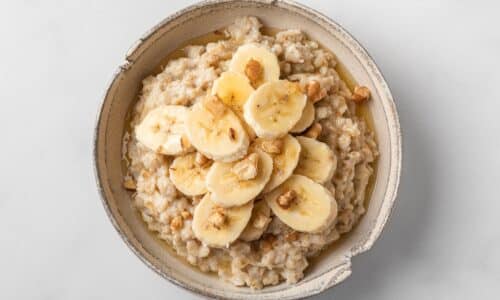
Oats contain a soluble fiber called beta glucan that helps stabilize blood sugar levels, ideal for diabetics. They also reduce cholesterol, and foster beneficial gut bacteria. But oats alone might not contain enough fiber (a half-cup serving contains about 5 grams) to keep those blood sugar levels where they need to be. That’s why it’s a good idea to add walnuts (or a protein of choice, such as a hard-boiled egg) to oatmeal to stay satisfied and energized longer. Need ideas? Try these 10 creative ways to add protein to your oatmeal.
-
2. Greek yogurt with blueberries and almonds
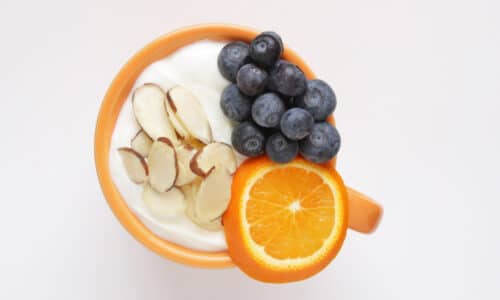
Plain yogurt (Greek, especially) is low in sugar and carbs, and high in protein. Always opt for an unsweetened version to avoid added sugars, and add blueberries (or other berries), almonds and a dash of cinnamon.
Yogurt is made from milk that’s cultured and fermented. The fermentation helps naturally preserve yogurt while giving it its tangy flavor and the gut-friendly bacteria from probiotics, which can help normalize metabolism in diabetes patients. Blueberries are a diabetes superfood because of their antioxidants and fiber, while almonds help to control blood sugar levels and decrease the risk of heart disease in people with Type 2 diabetes, according to a 2017 study.
RELATED: This or That? Regular Yogurt Vs. Greek Yogurt (Or Both)?
-
3. Cottage cheese with cantaloupe and ground flaxseed

Cottage cheese is an excellent choice for a low-calorie, low-sugar and high-protein breakfast or snack. It’s also a great source of calcium. Like yogurt, cottage cheese also employs cultures to create its signature curds and boost your microbiome with gut-friendly bacteria. Adding cantaloupe raises this breakfast option’s nutrient profile even more. Cantaloupe is loaded with antioxidants (to reduce cell damage and inflammation), beta carotene for eye health, and is rich in potassium for heart, muscle and cell health. The flax seeds are also a good source of anti-inflammatory omega-3s.
-
4. Energy bites made of nut butter, oats and seeds
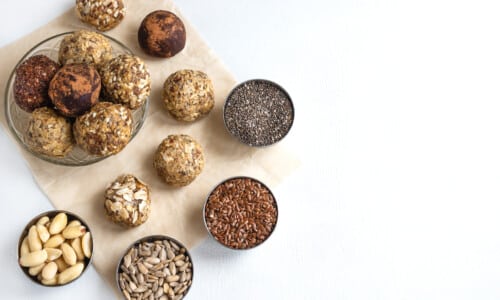
Energy bites are an ideal meal (or snack) that provides protein and healthy fats to keep you satisfied longer and give you energy without a sugar crash.
Our Energy-Boosting Peanut Butter Bites include healthy omega-3 fats from flax, protein from the peanut butter and chia seeds, and more fat and fiber from shredded coconut. The ground flaxseed has anti-inflammatory omega-3s and is easier to digest than whole flax seeds, which can be hard for the body to break down. Note: This sweet snack does include honey, so depending upon your medical condition you may want to cut it in half or simply keep it out of the recipe altogether.
-
5. Chia seed pudding
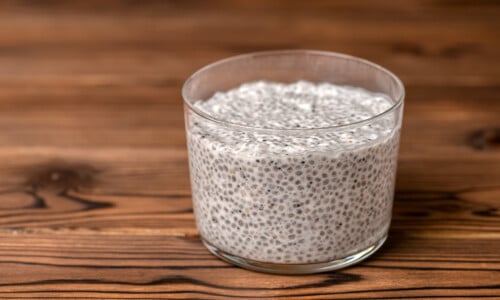
Chia seed pudding is packed with protein and healthy fats that can be eaten any time of day really. This delicious dish can be a breakfast epiphany for people with diabetes, according to The DiaTribe Foundation, because it has little impact on blood sugar, is super filling and is infinitely customizable. Chia seeds offer heart-healthy omega-3 fatty acids and two tablespoons contain 4 grams of protein.
For people living with diabetes, nutrition is a key component in their journey to maintaining good health. And for the millions who have it, working with a dietitian and/or nutrition and wellness coach can be a game-changer.
(Images: Shutterstock)
Seka Palikuca is the Editorial Content Manager at Nutritious Life. Before joining the NL team, she was a journalist with the Chicago Tribune for over two decades and a senior writer and editor for the American Osteopathic Association. In this role, she marries her dedication to the craft of writing with her passion for a whole-person approach to health and wellness.
RECENT ARTICLES

Want a sneak peek inside the program?
Get FREE access to some of the core training materials that make up our signature program – Become a Nutrition Coach.
Get Access"*" indicates required fields
 Eat Empowered
Eat Empowered

